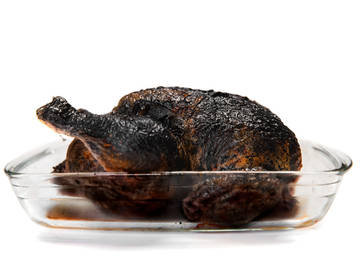The Charred Truth: Unpacking Your Burnt Little Caesars Pizza Experience
Few things are as universally disappointing as eagerly opening a pizza box, only to be greeted by the unmistakable aroma and sight of a burnt Little Caesars pizza. That moment, often filled with anticipation for a quick, affordable, and satisfying meal, can quickly turn into a frustrating encounter with overcooked crusts, hardened cheese, and a bitter aftertaste. It’s a common complaint, echoed across social media and in countless customer service interactions, highlighting a consistent challenge for both consumers and the fast-food giant.
This article delves deep into the phenomenon of burnt Little Caesars pizza, exploring the reasons behind it, its impact on your dining experience and even your health, and what steps you can take if you find yourself with a less-than-perfect pie. We'll examine the delicate balance between a perfectly golden crust and one that has crossed the line into carbonization, offering insights into the culinary science at play and practical advice for both prevention and resolution. Understanding this issue is key to ensuring you get the quality and value you expect from your pizza purchase.
Table of Contents
- The Culinary Conundrum: What Makes Pizza "Burnt"?
- "Burnt" vs. "Burned": A Linguistic Detour
- Why Does My Little Caesars Pizza Get Burnt? Common Culprits
- The Impact of Burnt Pizza: More Than Just a Taste Issue
- Consumer Expectations vs. Reality: The Little Caesars Promise
- What to Do When You Get a Burnt Little Caesars Pizza
- Preventing the Charred Catastrophe: Tips for Little Caesars and Consumers
- Beyond the Burn: The Bigger Picture of Fast Food Quality
The Culinary Conundrum: What Makes Pizza "Burnt"?
Defining "burnt" can be subjective, but in the context of pizza, it generally refers to areas of the crust, cheese, or toppings that have been excessively exposed to heat, resulting in a dark, often black, appearance and a bitter, acrid taste. This goes beyond the desired charring that some artisan pizzas aim for, which is usually a light crispness and smoky flavor.
Understanding the Maillard Reaction and Charring
At the heart of delicious pizza crust lies the Maillard reaction, a complex chemical process responsible for the browning and flavor development in many cooked foods. It occurs when amino acids and reducing sugars react at high temperatures, creating hundreds of new flavor compounds and the appealing golden-brown color we associate with perfectly baked goods. This reaction is crucial for developing the savory, umami notes in pizza crust and cheese.
However, if the heat continues beyond the optimal point, the Maillard reaction gives way to pyrolysis, or charring. This is essentially the burning of organic material. Instead of creating desirable flavor compounds, charring produces carbon, leading to the black, brittle texture and bitter taste of a burnt Little Caesars pizza. The difference between a perfectly browned crust and a charred one is often a matter of seconds in a high-temperature oven, making precise timing and temperature control paramount.
The Fine Line Between Crispy and Carbonized
For many pizza lovers, a crispy crust is a sign of a well-made pizza. This crispness is achieved when moisture evaporates from the dough, and the outer layer undergoes the Maillard reaction, firming up and developing a pleasant crunch. However, there's a very fine line between this desired crispiness and carbonization. When the heat is too intense, or the pizza is left in the oven for too long, the sugars and proteins in the dough and cheese rapidly degrade, turning black and brittle. The result is a crust that shatters rather than crunches, and cheese that tastes like ash rather than rich and gooey. This is the unfortunate reality of a truly burnt Little Caesars pizza – it’s not just overcooked; it’s fundamentally altered in a way that compromises its edibility and enjoyment.
"Burnt" vs. "Burned": A Linguistic Detour
Before we delve deeper into the mechanics and implications of a burnt Little Caesars pizza, it's worth taking a moment to address a common linguistic point of contention: "burnt" versus "burned." Both words are acceptable forms of the past tense and past participle of the verb "to burn." You might say, "The pizza was burned," or "I burned the pizza." Similarly, both can be used as adjectives: "burnt toast" or "burned toast."
However, there's a subtle nuance often observed, especially in American English, though both are widely understood. "Burned" often refers to the action itself, or a completed past action: "The chef burned the pizza." "Burnt," on the other hand, is more frequently used as an adjective describing the condition of something: "The burnt Little Caesars pizza was inedible." If you recall that guideline – "burnt" for the condition, "burned" for the action – you'll always be able to use each of these words in the right way. Regardless of whether you prefer to describe it as a "burnt Little Caesars pizza" or a "burned Little Caesars pizza," the frustration and disappointment remain the same for the customer.
Why Does My Little Caesars Pizza Get Burnt? Common Culprits
The journey from fresh dough to a perfectly baked pizza is fraught with potential pitfalls. Several factors can contribute to a Little Caesars pizza emerging from the oven in a less-than-ideal, burnt state. Understanding these can help shed light on why this issue is so prevalent.
Oven Temperature and Calibration Issues
Commercial pizza ovens, especially those used in high-volume fast-food establishments like Little Caesars, operate at extremely high temperatures to cook pizzas quickly. However, consistent temperature is key. If an oven is not properly calibrated, it might run hotter than its display indicates, or have "hot spots" where certain areas receive more intense heat. This can lead to uneven cooking, where one part of the pizza is perfectly done while another is burnt. Furthermore, if the oven conveyor belt speed is not correctly set for the actual temperature, pizzas can spend too long in the intense heat, inevitably leading to a burnt Little Caesars pizza.
Maintenance plays a crucial role here. Ovens need regular cleaning and calibration to ensure consistent performance. Grease buildup or debris can also affect heat distribution, contributing to localized burning. Without diligent oversight, even the most advanced ovens can produce subpar results.
Dough Consistency and Topping Distribution
The dough itself is a critical factor. Little Caesars uses a standardized dough, but slight variations in moisture content or thickness can occur. A thinner spot in the dough, or a dough that is slightly drier than intended, will cook faster and be more prone to burning. Similarly, the distribution of toppings matters. Areas with less cheese or sauce might expose the crust directly to the intense heat, making it more susceptible to charring. For example, if a pepperoni slice slides off a section of crust, that exposed area can quickly become a burnt spot. While Little Caesars aims for consistency, the sheer volume of pizzas produced means minor variations can accumulate, increasing the likelihood of a burnt Little Caesars pizza being served.
The Impact of Burnt Pizza: More Than Just a Taste Issue
Receiving a burnt Little Caesars pizza isn't just about a spoiled meal; it has broader implications, affecting consumer satisfaction, brand perception, and even potential health considerations.
From a taste perspective, burnt food is simply unpleasant. The bitter, acrid notes overpower any intended flavors, making the pizza largely inedible. This leads to wasted food and money, as customers are unlikely to finish a pizza that tastes like ash. The visual appeal is also destroyed; a black, charred pizza is far from appetizing and can instantly turn off a customer.
Beyond the immediate sensory experience, repeated instances of burnt Little Caesars pizza can erode customer trust. If a customer consistently receives a poor-quality product, they will eventually take their business elsewhere, impacting the brand's reputation and bottom line. In today's highly competitive fast-food market, consistency and quality are paramount for retaining customers.
Health Implications of Overcooked Food
While the occasional piece of burnt toast is unlikely to cause significant harm, consistent consumption of heavily charred foods can raise health concerns. When starchy foods like pizza crust are cooked at very high temperatures, especially to the point of charring, a chemical called acrylamide can form. Acrylamide is a chemical that has been classified as a "probable human carcinogen" by the International Agency for Research on Cancer (IARC).
Similarly, when meat (like pepperoni or sausage on a pizza) is cooked at very high temperatures, especially when it becomes charred, heterocyclic amines (HCAs) and polycyclic aromatic hydrocarbons (PAHs) can form. These compounds have also been linked to an increased risk of cancer in animal studies. While the amount of these compounds in a single burnt Little Caesars pizza might be small, regular consumption of highly charred foods over time could contribute to dietary exposure. This elevates the issue beyond mere taste preference to a matter of food safety and public health, making the prevention of burnt food a responsibility for food establishments.
Consumer Expectations vs. Reality: The Little Caesars Promise
Little Caesars has built its brand around convenience, speed, and affordability. Their "Hot-N-Ready" concept promises a fresh, hot pizza available for immediate pickup, eliminating wait times. This value proposition sets a specific expectation for consumers: a quick, no-fuss meal that delivers on its basic promise of a satisfying pizza. When a customer receives a burnt Little Caesars pizza, it directly contradicts this promise.
The expectation isn't for gourmet, artisan pizza; it's for a consistently decent, edible product. The low price point doesn't excuse poor quality; rather, it makes the disappointment of a burnt pizza even more acute, as the perceived value diminishes significantly. Customers are paying for a hot, ready-to-eat meal, and a burnt pizza fails on both counts – it might be hot, but it's certainly not ready to be enjoyed. This gap between the brand's promise and the delivered reality is where customer frustration truly brews, leading to negative reviews and lost business.
What to Do When You Get a Burnt Little Caesars Pizza
Discovering your Little Caesars pizza is burnt upon arriving home can be incredibly frustrating. However, you do have options. The best course of action is to address the issue directly with the store where you purchased it.
- Return to the Store Immediately: If possible, take the burnt pizza back to the Little Caesars location. Most reputable establishments, including Little Caesars, have policies in place to address customer dissatisfaction. Present the pizza and explain the issue calmly.
- Request a Replacement or Refund: Clearly state that the pizza is burnt and therefore unacceptable. You are typically entitled to either a fresh, properly cooked replacement pizza or a full refund. Be prepared to show the pizza as proof of its condition.
- Call the Store: If returning immediately isn't feasible, call the store. Describe the problem, mention your order details, and inquire about their policy for burnt or unsatisfactory orders. They might ask you to bring it back later or offer a credit for a future purchase.
- Keep Your Receipt: Always keep your receipt. It serves as proof of purchase and makes the resolution process much smoother.
- Provide Constructive Feedback: When you communicate with staff, be polite but firm. Explain what was wrong with the pizza. This feedback is valuable for the store to identify and rectify issues, whether it's an oven problem or staff training needs.
- Online Feedback/Social Media (as a last resort): If the store is uncooperative (which is rare for a chain like Little Caesars), you can escalate by contacting Little Caesars corporate customer service through their website or social media channels. Include photos of the burnt Little Caesars pizza if you have them. This should be a last resort, as direct communication with the store is usually the quickest way to resolve the issue.
Remember, you are a paying customer, and you have a right to receive a product that meets reasonable quality standards. Don't hesitate to advocate for yourself when you receive a burnt Little Caesars pizza.
Preventing the Charred Catastrophe: Tips for Little Caesars and Consumers
While the primary responsibility for preventing burnt Little Caesars pizza lies with the restaurant, there are steps both the establishment and the consumer can take to minimize the occurrence of this culinary mishap.
For Little Caesars Restaurants:
- Regular Oven Maintenance and Calibration: This is paramount. Ovens should be cleaned daily to prevent buildup, and temperatures and conveyor speeds should be regularly checked and calibrated by trained technicians to ensure consistent and even cooking.
- Staff Training and Oversight: Employees need thorough training on proper pizza preparation, including dough handling, even topping distribution, and oven monitoring. Managers should provide consistent oversight, especially during peak hours, to ensure quality control.
- Quality Control Checks: Implement a system where pizzas are briefly inspected before being boxed. A quick glance can often catch a visibly burnt Little Caesars pizza before it leaves the store.
- Responding to Customer Feedback: Take customer complaints about burnt pizzas seriously. These are valuable indicators of underlying operational issues that need to be addressed.
For Consumers:
- Inspect Before You Leave: If possible, take a quick peek at your pizza before you leave the store. While not always feasible with the "Hot-N-Ready" model, if you're ordering custom, this can save you a trip back.
- Order "Lightly Baked" (if available): Some pizzerias allow you to request a lighter bake. While Little Caesars' high-volume model might not always accommodate this for Hot-N-Ready, it's worth asking if you're ordering a custom pizza.
- Provide Constructive Feedback: As mentioned, don't just grumble. Politely inform the store or customer service about your burnt Little Caesars pizza. Your feedback helps them improve.
- Consider Your Oven at Home: If you're reheating leftover Little Caesars pizza, be mindful of your home oven's temperature and don't overcook it. The last thing you want is to burn it twice!
Beyond the Burn: The Bigger Picture of Fast Food Quality
The issue of burnt Little Caesars pizza, while specific, is symptomatic of a broader challenge within the fast-food industry: balancing speed and affordability with consistent quality. Fast-food chains operate on razor-thin margins and rely on high volume. This often means standardized processes, minimal human intervention, and rapid production cycles. While efficient, this model can sometimes compromise the individual attention to detail that ensures a perfect product every time.
Consumers today are increasingly discerning, even when it comes to budget-friendly options. Social media amplifies both positive and negative experiences, making brand reputation more fragile than ever. A single photo of a burnt Little Caesars pizza can go viral, causing significant damage. Therefore, for chains like Little Caesars, investing in robust quality control, continuous staff training, and responsive customer service isn't just about good business practice; it's essential for long-term survival and brand loyalty in a competitive market. The pursuit of speed should never entirely overshadow the commitment to delivering an edible, enjoyable product.
Conclusion
The experience of receiving a burnt Little Caesars pizza is a frustrating reality for many consumers. It's a clear example of how a slight misstep in the cooking process can transform an anticipated meal into a disappointing one, highlighting the delicate balance between perfect browning and destructive charring. From the nuances of oven calibration to the consistency of dough, numerous factors contribute to this common issue, impacting not only taste but potentially raising minor health concerns.
Understanding why your pizza might be burnt empowers you as a consumer. Remember that you have the right to a quality product, and don't hesitate to communicate with the store if you receive a less-than-perfect pie. By providing feedback and advocating for yourself, you contribute to better quality control for everyone. Ultimately, whether you say "burnt" or "burned," the goal remains the same: a delicious, hot, and ready pizza that lives up to its promise. Let's hope for more golden crusts and fewer charred disappointments in our future pizza endeavors!
Have you ever received a burnt Little Caesars pizza? Share your experiences and any tips you have in the comments below! And if you found this article insightful, consider sharing it with fellow pizza lovers or exploring our other guides on navigating the world of fast food.

Burnt: Thoughts on the Film Opening Tonight - D Magazine

Burnt (2015) - Posters — The Movie Database (TMDB)

Burnt or Burned: Which is Right? | Merriam-Webster